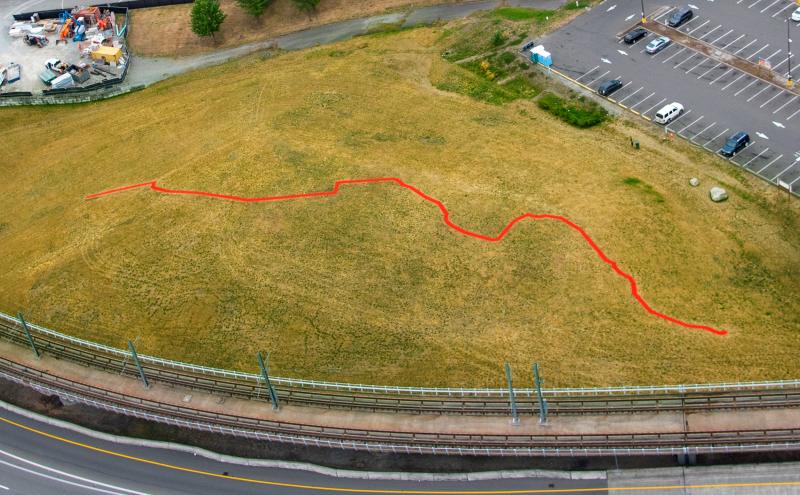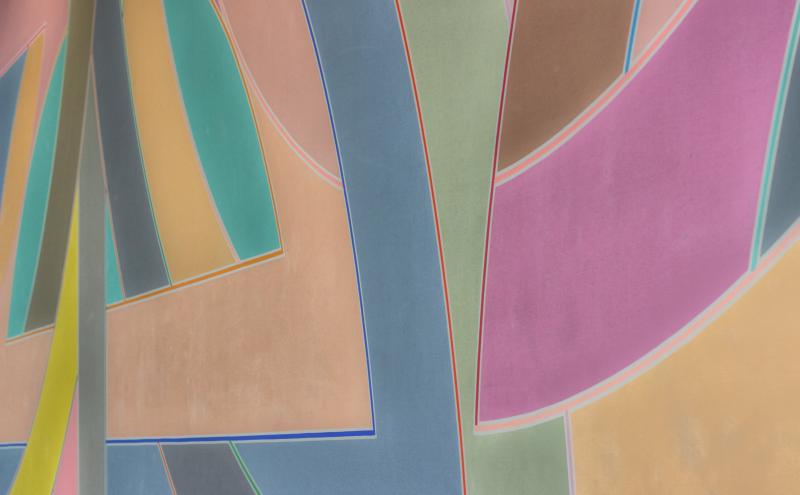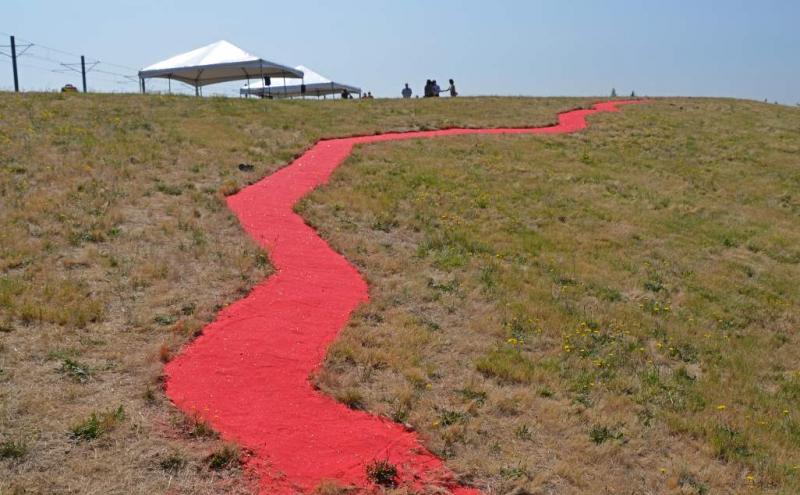
New Sea-Tac Art Installation Draws Attention to Immigration and Human Trafficking
A 350-foot long, two-foot wide art installation, which replicates the US-Mexico border in red sand, is now open at Sea-Tac Airport and will stay open for the remainder of the year. The large-scale earthwork, which will be visible to travelers in flight and on the ground at Sea-Tac, is called Red Sand Project: Border US-MX, and fosters conversation on human trafficking and immigration.
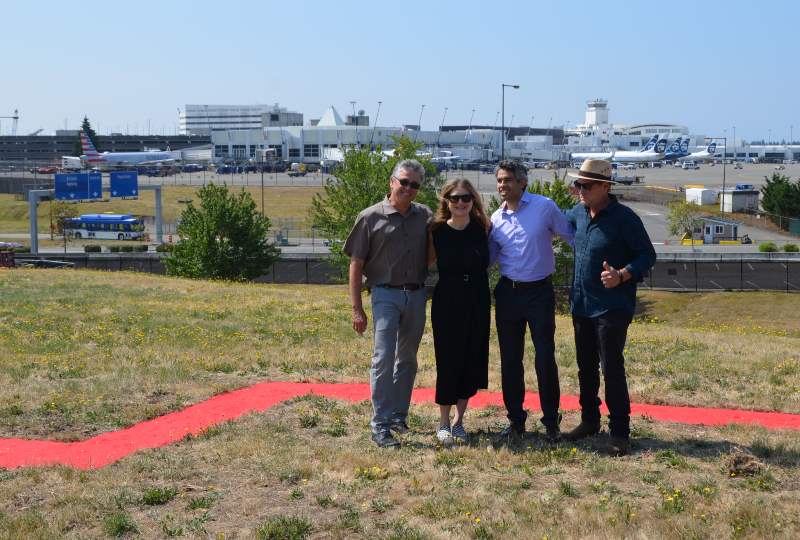
Created by New York-based artist and activist Molly Gochman, this is the first exterior temporary artwork ever featured at Sea-Tac Airport, and encourages more people to look to the airport as a place to experience art. The piece was installed to coincide with the Seattle Art Fair, and is part of a long-term vision to present the work at airports and other highly visible public sites across the country.
The presentation of Red Sand Project: Border US-MX dovetails with Sea-Tac Airport’s own efforts to bring awareness to human trafficking. In January 2018, the Port of Seattle Commission passed a motion directing staff to implement a port-wide anti-trafficking strategy. And earlier this year, the Port joined other organizations to launch a public awareness campaign, encouraging survivors to call a national hotline for assistance at 888-373-7888, text 233-733, or visit WATraffickingHelp.org.
Gochman’s work brings visibility to human trafficking and the social structures that allow its continued proliferation. It is part of the Red Sand Project, a participatory artwork project that invites people to have conversations about human trafficking and exploitation into public dialogue by pouring red sand into sidewalk cracks.
We caught up with Gochman to learn more about the Red Sand Project: Border US-MX, and her answers below show how she hopes to inspire social change.
Port: What was your inspiration for creating the Red Sand Project: Border US-MX piece?
Gochman: The central question in the Red Sand Project is, “How can we act to address vulnerabilities, and what are the vulnerabilities that lead to exploitation?” I have found that discrimination is a vulnerability that makes people extremely susceptible to exploitation and is also the hardest to address. As an example, when people do not have immigration status, and are discriminated against because of it, they are substantially more susceptible to being exploited. I created this earthwork in the shape of the US-Mexico border to deepen the conversation around what it means to be vulnerable, and the ways migration status can make people more vulnerable.
Port: What is the meaning of using sidewalk cracks as an element of public participation?
Gochman: Sidewalk cracks are a metaphor for vulnerable populations that exist all around us; by filling the sidewalk cracks with red sand, we can all draw attention to the ways in which we walk over those who are marginalized. The act of putting the sand in the sidewalk crack helps us to visualize how our actions, big or small, can add up and make a difference.
Port: Tell me how the earthwork is created and installed.
Gochman: It takes a community to install an earthwork.
After selecting a site, I use a surveyor to plot the lines of the border on the land.
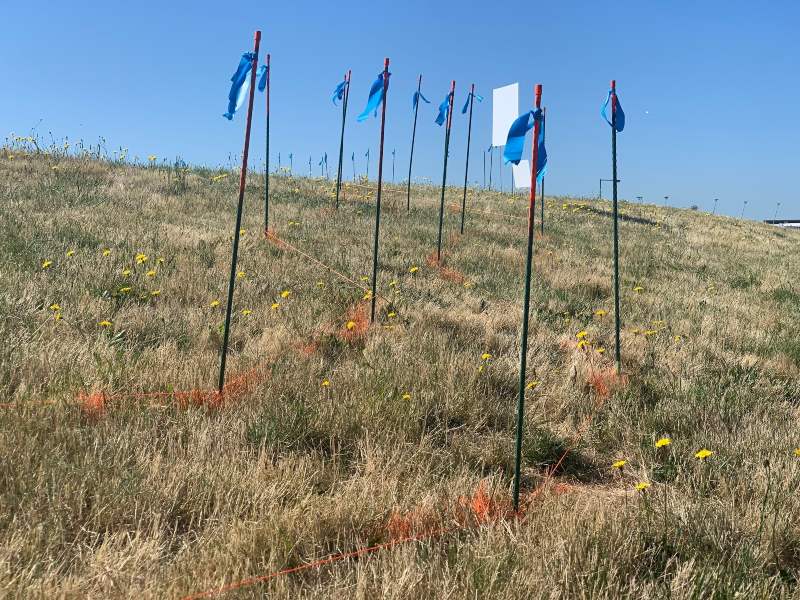
Then we dig up the earth and lay down a concrete layer to ensure that the earthwork is strong enough to support people walking on it and interacting with it.
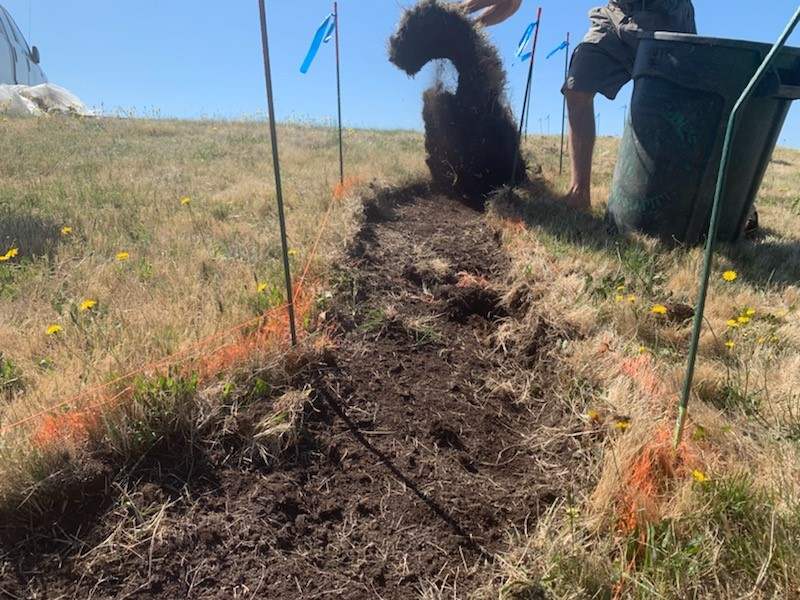
On top of the concrete we put a mixture of red sand and art-grade resin, filling this large crack in the earth with red sand so it’s visible from the air and the ground. Installation is dependent on the weather, as rain or humidity can affect the way the materials set. It can take anywhere from three to eight days to install an earthwork, depending on the scale.
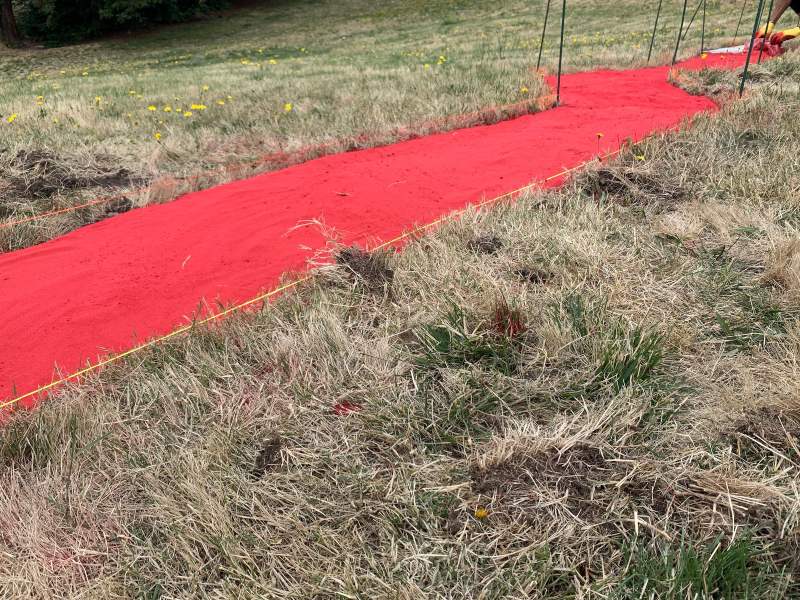
Port: As an artist, why did you decide it was important to take a stand on human trafficking? How are people responding to it?
Gochman: As a human, I became so disturbed by modern day slavery that I wanted to leverage my resources to address it. I want Red Sand Project to support wider systemic change, and a way to influence that is by getting more people involved and helping them understand the origins and scope of the problem. As an example, many people don’t know that over 60 percent of the children sold for sex in the U.S. have spent time in the foster care system. We need more supports for these children to decrease their vulnerability. In my experience, people want to make a difference — they want to take a stand and be in community. People respond well to this project because it allows them to do something tangible, to actively engage and hopefully to inspire more people too. Survivors of human trafficking have also responded positively to the project, because they feel it continues the conversation around human trafficking without using exploitative images.
Port: How is your work a vehicle for change?
Gochman: Art connects us. Art deepens our empathic abilities, which diminishes the sense of otherness among people and drives social change. There can be a lot of barriers to conversation on difficult subjects. Art can serve as a bridge, providing a mutual experience that can spark dialogue.
Port: Why did you decide to create a public participation element to the project and what has the impact been? How can people get involved?
Gochman: The physicality of participation is critical, because the act of pouring red sand or joining a program around the installation creates a deeper relationship with the subject. When you see online or read in a pamphlet that more than 40 million people are enslaved today, that can feel very overwhelming, and it’s easy to put it to the side. It feels ephemeral. But when you actively engage — when there are other people to speak to, when there is a physical action, then you create a more robust connection to the subject, and it can more readily inspire more action.
Port: How can people get involved?
Gochman: It’s easy to get involved in the Red Sand Project — anyone can do it. You just need to get a group of people together and visit the website where you can order materials and get more information. Together, you can work to raise awareness in your community.
To see the installation:
Red Sand Project: Border US-MX may be visible from the sky from your departing and landing flights, depending upon approach; from the Link Light Rail, both approaching and leaving the airport; from the top deck of the parking garage; and from inside the airport at Concourses N and D.
Individuals who wish to see the installation up close can access it via the Cell Phone Lot at 2623 S. 170th Street.
Information regarding the installation will be available inside the airport to help travelers understand what they are seeing in flight and on the ground.


